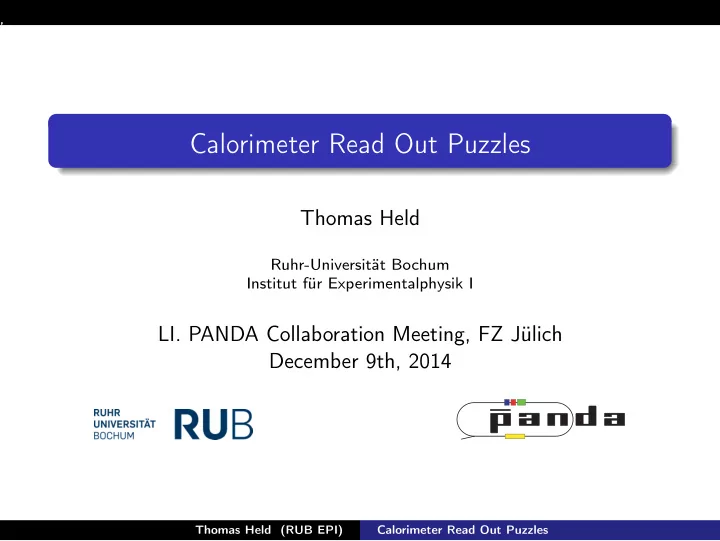

, Calorimeter Read Out Puzzles Thomas Held Ruhr-Universität Bochum Institut für Experimentalphysik I LI. PANDA Collaboration Meeting, FZ Jülich December 9th, 2014 Thomas Held (RUB EPI) Calorimeter Read Out Puzzles
, Proto192: 2014 ELSA beam time Remember: Response of the two APDs on most of the crystals in the ’final’ APD-equipped subunit of the Proto192 differs seriously! All APDs gain measured All APDs biased to gain 200 (within ’pairing deviations’ of up to 2 V) Different deviations for beam data and light pulser runs Thomas Held (RUB EPI) Calorimeter Read Out Puzzles
, Proto192: Back in Bochum Rewiring to individual bias supply for each APD in order to get rid of ’pairing deviations’ Measuring gain of every single shaper channel (some % deviation) → Picture slightly modified but basically remains the same Cosmics taken in Bochum: same deviations as Bonn beam data → LED light pulses too different to scintillation light pulses? Comparison of risetimes of preamp pulses: response to light pulser: (45 ± 1/52 ± 1) ns response to cosmics: (80 ± 2) ns (There are preamps that clearly respond with different output pulse shapes to the same LED light pulses!) Thomas Held (RUB EPI) Calorimeter Read Out Puzzles
, Proto192: Back in Bochum Feeding the shaper with pulses of those different rise times (45 vs. 80 ns from a function generator) results in about 30 % pulse height difference!! However, the response ratios of the two APD-read out channels of one crystal is almost unaffected What effect does the difference between LED and szintillation light wavelength peak (420/430 nm) and width (LED much narrower) have? What is the spread of spectral response QE( λ ) of the APDs? Neither a gain reduction of the APDs to 100 nor intensity variations with the light pulser (5...80 % ) do change the results Thomas Held (RUB EPI) Calorimeter Read Out Puzzles
, APD screening Bochum Example of a screening of the two APDs on crystal 1 Blue and red: DC gain curves Black and magenta: AC yield curves (how to normalize?) From the -25 o C gain curves point of view these two APDs should very well match - in fact (Proto192) they do not! xtal 1 3 10 2 10 gain | yield 1 10 0 10 -1 10 0 50 100 150 200 250 300 350 400 U / V Thomas Held (RUB EPI) Calorimeter Read Out Puzzles
, APD screening Bochum Example of a dark current curve at +20 o C Blue: Bochum measurement Red: APD lab GSI measurement Where do the differences come from? 3 10 2 10 1 10 0 10 I / uA -1 10 -2 10 -3 10 -4 10 0 50 100 150 200 250 300 350 400 450 U / V Thomas Held (RUB EPI) Calorimeter Read Out Puzzles
, Summary We see different responses of the two read out channels with most of the crystals in our ’final’ APD subunit APDs individually biased to gain 200 The difference in output depends on the source of light: Scintillation light (beam data, cosmics) LED ’PWO-like’ light pulses (somewhat less difference) Wavelength and spectral Thomas Held (RUB EPI) Calorimeter Read Out Puzzles
, Summary Optical coupling unlikely to cause the effect (Dow Corning glue), even though we can check only after dismantling the subunit VPTTs are coupled with the same adhesive and show uniform responses just as expected However, APDs are placed in capsule before glueing: Can a differing amount of glue or slightly non-parallel positioning in capsule cause trouble? The major source of the difference in response of the two read out channels on one crystal seems to come from the APDs The output differs even though the gain is properly adjusted (200 or 100, single APD-HV supplies) How much differ the quantum efficiences and hence the total yields of the APDs? Thomas Held (RUB EPI) Calorimeter Read Out Puzzles
, Conclusion Unless there are no further ideas of what still to measure on the APD-subunit in the Proto192 we will take it out and dismantle it for further inspection We need detailed APD data (pulsed characteristic curves, QE( λ ) curves, capacity curves) in order to sufficiently understand the devices for proper matching We need to find the reason for the varying output pulse shapes of the preamps (tolerances of components?) We need modified shapers: less sensitivity to input pulse rise time (higher shaper bandwidth) gain maximum at pulse shape relevant frequencies Thomas Held (RUB EPI) Calorimeter Read Out Puzzles
Recommend
More recommend